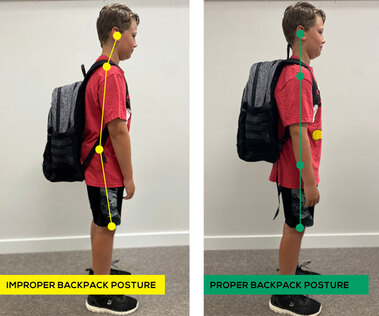1. CHOOSE THE RIGHT BACKPACK & WEAR IT CORRECTLY An ill-fitting, incorrectly worn or overweight backpack can be a precursor to spinal issues, contribute to bad posture, and even worsen existing problems. Below are a few pointers to follow when shopping for a new backpack:
2. PRACTICE PROPER CLASSROOM POSTURE
Proper posture: we know it’s important but most of us, especially children, do not consciously think about posture throughout the day. Correct posture plays a significant role in not just how we present ourselves to the world, but it can have significant effects on our overall health. How? Our spine surrounds and protects our spinal cord which is the most important part of our nervous system. Without proper spinal alignment, the nervous system can become compromised which can lead to a variety of different symptoms throughout the body. Here are 5 ways to support proper posture:
On average, U.S. students spend at least four and half hours sitting during the school day. For kids ages 8-18, an additional seven hours a day is spent in front of a screen. Combine the sitting at school and in front of a screen with driving to school, doing homework, and eating meals, kids are sitting 85% of their waking hours*! Our bodies are not designed to sit for that many hours in a day and the toll it’s taking on our spines is often manifesting itself as neck pain, sore muscles, mid-back pain, headaches, among other issues. Proper posture, in addition to spinal maintenance through regular exercise and chiropractic adjustments, can help mitigate these risks and prevent future issues. Together, they can ensure a strong, healthy, and confident start for your student this school year! By Dr. Kevin Clark *Source: 2010 survey by Kaiser Family Foundation – Generation M2: Media in the Lives of 8-18 Year Olds
0 Comments
The “treatment”? A night of quality, deep sleep.
Unfortunately, sleep in America is a total nightmare. According to sleep scientist and author of “Why We Sleep”, Dr. Matthew Walker, the average amount of sleep American adults get a night is around six hours and 31 minutes (in 1942, it was 7.9 hours). Interestingly enough, humans are the ONLY species on the planet to deprive themselves of sleep for no clear or beneficial reason. Think about that for a second. Why do we do this to ourselves when the benefits are so obvious? Many chalk it up to the busy lifestyles that we are consumed by each day. The culture of “busy” is often glorified while sleep and rest are looked down upon. But sleep is the foundation for optimal health and cognitive function. I often tell patients that if they have the choice between working out or sleeping, I tell them to sleep. Sleep gives time for our body’s systems to rest, heal, and recalibrate. So how can you start finding those oh-so-sweet dreams every night? Here are three things you can start doing right away to help improve your sleep and get you on your path towards consistent nights of quality, deep sleep. 1. GET MORNING LIGHT Go outside first thing every morning for at least 5-10 minutes to expose your eyes to natural sunlight (even if the sun is behind the clouds). This will help support and stabilize your circadian rhythm (your body’s master clock), sending signals to generate alertness and keep us awake and active throughout the day. At night, it initiates the production of melatonin (hormone that promotes sleep) and keeps transmitting signals that help us STAY asleep. 2. REDUCE SCREEN TIME & LIGHT EXPOSURE Blue light (from phones, computers, & tablets) suppresses melatonin production and STOPS it from being released causing us to stay alert throughout the night. An hour or so before your bedtime, switch your phone to Night Mode. This will change your screen color to a red tint (vs. the blue light). Here’s a link to instructions on how to quickly set this up on your iPhone. Try to keep your bedroom screen-free. Or, at least put your phone on airplane mode and replace scrolling time with reading or journaling to help your mind wind-down. The goal is to give your body the correct signals that night is coming, NOT that it needs to stay alert and awake. 3. FIND THE RIGHT TEMPERATURE Our central nervous system needs to drop two to three degrees from our baseline in order to get into our deepest sleep, as Dr. Matthew Walker shares on the Joe Rogan Experience podcast. Try adjusting your thermostat to bring down the temperature in your room. Another great way to help you wind down and decrease your internal body temperature is to take a warm bath before bed. This may sound counterintuitive but hear me out. When you take a hot bath, vasodilation occurs (this is a natural process that increases blood flow and decreases blood pressure). While you are enjoying your bath, blood rushes to the surface of your body. When you get out of the bath, a massive dump of body heat occurs causing your core body temperature to drop. So, why does a chiropractor care about sleep? Most people view chiropractors as only “back pain” doctors, but that's only partially true. Sure, we help relieve back pain but at the heart of it, chiropractors are nervous system doctors. And one of the main benefits of chiropractic is the balancing of the nervous system. Many patients of mine comment on how they sleep so much better after an adjustment. Why is that? Due to our high-paced, go-go-go lifestyle, most of us are stuck on overdrive with the sympathetic side of the nervous system turned on, aka "fight or flight" mode. Chiropractic care helps tone down the sympathetic side of the nervous system and activates the parasympathetic, "rest and digest", side–thus helping people sleep better. Looking for more tips? Leave a comment below with any questions or let us know what works for you! Improving your sleep can be a process but it’s worth it to wake up feeling refreshed and ready for the day. By Dr. Kevin Clark
Below are three tips to help spot the difference between the two: 1. Timing Normally, muscle soreness shows up following a workout and lasts ~ 24-48 hours. If you feel intense pain or soreness instantly, that usually means an injury has occurred. Additionally, if the soreness or discomfort following a workout does not subside after ~4 days, this also may indicate an injury has occurred. 2. Location The location of your pain or discomfort can provide a lot of information. As a whole, muscle pain is felt broadly. If you have pain that you are able to pinpoint (i.e. a specific area in your low back), this typically is a sign of an injury. 3. 1-Sided vs. 2-Sided General muscle soreness usually shows up on both sides of the body because we engage both sides of our body when exercising. If intense discomfort or pain is felt on only one side of the body, it’s a greater indicator that an injury has taken place. So, what can you do? Listen to your body. If your house is on fire, the fire alarm hopefully sounds off right away to tell you that help is needed ASAP. Our bodies function similarly and have their own alarm system to warn us when something is wrong with our health. That alarm system is pain. While pain never feels good, it does mean that our bodies are functioning properly and alerting us that our body needs attention. The longer we let the alarm sound off, the more damage that is done to our house (or bodies). It is important to seek professional help, like a chiropractor, to help heal the injury as soon as possible. By Dr. Kevin Clark |
�
About the DocDr. Clark is the owner and head chiropractor of Clark Chiropractic in Darien, IL. He is a 4th-generation chiropractor with a passion for wellness. He enjoys researching the latest ways to increase longevity, cooking with his family, spending time outside, and helping patients live an active lifestyle. Archives
January 2024
Categories
All
|
|
Hours:
Monday, Wednesday, & Thursday: 7:45 AM - 11:00 AM + 3:00 PM - 6:30 PM Tuesday: 11:00 AM - 2:00 PM Saturday: 8:00 AM - 10:30 AM |



 RSS Feed
RSS Feed
